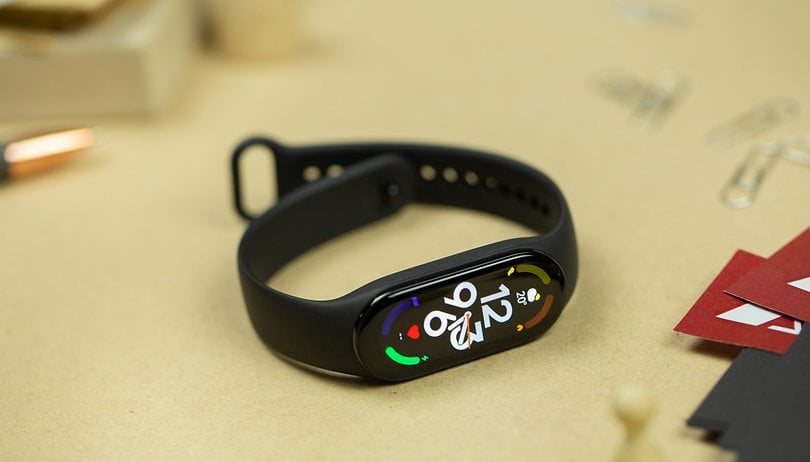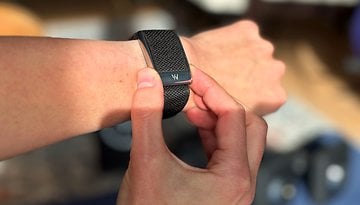Xiaomi Smart Band 7 review: The best gets a little bit better


Xiaomi does not do much differently with the Smart Band 7, but some things are better. The price has increased, but the fitness tracker also has some new tricks on board. Read this review to find out whether that is enough to earn a good rating in the NextPit test.
Good
- Larger and brighter display
- Always-on display
- Larger battery
- Many new sports modes
- Sufficient battery life
Bad
- No NFC
- No GPS
- No wireless charging
- Unclear app policy
- Mi Fitness app still with weaknesses

Xiaomi Smart Band 7 in a nutshell
Xiaomi makes a very good fitness tracker just a little bit better. Period. However, it still leaves a somewhat stale aftertaste. New features, a larger AMOLED screen and a thicker battery are all well and good - but I would really like to see NFC, GPS and, best of all, wireless charging on my trusted Mi or Smart Band.
Xiaomi now charges a hefty 60 Euros for the fitness wristband beyond the early-bird price, which is a bit over the top in my opinion. Nevertheless, the Smart Band 7 is a top device that not only satisfies would-be athletes like me, but also the more demanding ones among you.
With permanent SpO2 monitoring, further improvements of the existing features and the increase of the sports modes to now over 120, Xiaomi has kicked things up a notch functionally. Nevertheless, I believe that Mi Band 6 owners can safely wait for the next model. For everyone else who is interested, the Smart Band 7 is an absolute bank—just like we are used to from Xiaomi every year.
Design & display: A little bit bigger
Once again, Xiaomi enlarges the Smart Band 7's display. In addition, the resolution increases adequately, there is always-on functionality, and the display is also a bit brighter. That's good, Xiaomi!
Likes:
- Larger display
- Always-on display
- Usual good build quality
- Brightness continuously adjustable
Dislikes:
- Still no ambient light sensor
Aesthetically, almost nothing has changed. The shape and material are therefore familiar: This means that the replaceable wristband is still made of plastic (TPU), while the display is protected from scratches by 2.5D glass. Xiaomi also maintains the usual high level in terms of build quality.

The wristband is still equipped with the familiar clasp. The 13.5 gram (without wristband) light device is still pleasant to wear - basically, you will forget that you are wearing it at all. While there were six colors to choose from last year, the wristband is now available in ten color options: black, orange, olive, pink, ivory, blue; and with the Exclusive Edition: neon green, neon orange, khaki green, khaki blue.

You'll notice that the old wristbands won't fit on the new tracker, and there's a reason for that: the display has now grown to 1.62 inches. With a resolution of 192 x 490 pixels (another upgrade), the Smart Band 7 brings it to a pixel density of 326 ppi. The panel has mainly grown in width so that content can be read and clicked better.
- Read also:
There is a small change in terms of brightness, but the upgrade from 450 to 500 nits does not really matter. Unfortunately, an ambient light sensor that automatically regulates the brightness is still missing, but at least the brightness is now continuously adjustable, whereas before you had to settle for five brightness levels in the Mi Band 6.

The Always-On display, which is available for the first time, is also striking. It constantly shows you data like time and date, but is disabled by default. This is perhaps a good thing, because this feature naturally drains the battery. You can choose from a handful of preloaded Watch Faces, but over 100 more are available for download via the app.
Software and operation: Not much new at Xiaomi
Not much has changed in terms of operation with the Smart Band 7, which is obvious since the predecessor could already be operated very intuitively last year.
Likes:
- Revised interface
Dislikes:
- App clutter
We could actually skip this point because not much has changed in terms of operation since our review of the Mi Band 6. Xiaomi did away with the button underneath the display for the first time in the aforementioned Mi Band 6. At that time, you could only access the desired menu items on the fitness tracker by swiping. Now, instead of six widgets, you can create ten widgets next to the home screen, accessible via lateral swipes. These include the music player, weather, training, heart rate, and more.
The interface does not offer any big surprises, although we tried to use the screen's width optimally with minor optimizations. This makes the AMOLED display even easier to read than on the predecessor. Those who have used one of Xiaomi's last fitness trackers will immediately find their way around the Smart Band 7.

There is one thing that is a bit annoying about the operation, and that has to do with the various apps that can be used for the Smart Band 7 on the smartphone. The "Mi Fitness" app has been introduced, but it is only compatible with a few Xiaomi wearables. In addition, the previous companion app - Mi Fit - has been renamed Zepp Life.
Zepp Life is actually from Huami, which also offers its own smartwatches, but is obviously closely linked to Xiaomi. However, you should not confuse this app with the Zepp app (without the addition of "Life"), which is not intended for Xiaomi wearables. Zepp Life lets you connect the Smart Band with Google Fit, but Mi Fitness does not. Mi Fitness allows linking with Strava, but not with any other app.
Mi Fitness recently received bad reviews on Google Play, ranging from problems when pairing with the devices to inaccurate tracking and non-functioning features. In testing, I noticed a few other minor issues, such as delayed messages. My highlight in this regard was a call from my boss Fabi. I received the call notification on the Smart Band 7 when I had already been talking to him for two minutes.

I don't want to make too much of this, though, because the app otherwise does what it's supposed to: it gives me lots of stats and info! I also hope that the issues are teething problems that will be fixed quickly with software updates.
Features and tracking
The number of sports modes has simply been quadrupled - kudos, Xiaomi. Moreover, you can now permanently run the SpO2 tracking in addition to the heart rate monitoring.
Likes:
- 120 sport modes
- Permanent SpO2 tracking
Dislikes:
- Inaccurate sleep tracking
The Mi Band 6 came with 30 sports modes, but the Smart Band 7 handles a whopping 120. Of course, the previous modes like running, cycling and many others are included. However, you can also record yoga, Pilates and dancing, as well as workouts on the battle rope or parallel bars. When you swim, even the swimming style is automatically detected.
- Read also: These are the current best fitness trackers
I'm more of a "speed walker" myself, by which I mean that I walk relatively quickly. So, I went for a walk and tracked the distance with Mi Fitness, Google Fit and the adidas Runtastic app. Google Fit is often a bit overconfident and certifies that I covered well over four kilometers on this test lap. Runtastic recorded 2.87 km and Mi Fitness came in at 2.96. That's a difference I can happily live with, but I find it astonishing that the fitness wristband certifies that I only slept for two hours last night. I really don't sleep much, but it was still significantly more than 120 minutes.
In addition, there are other functions for which the purchase of the fitness tracker is worthwhile. You can permanently measure the oxygen saturation in the blood (SpO2) as well as the heart rate, and you can also select the desired intervals in which your pulse is taken in the app. You can measure your heart rate every minute at most, but you have to keep in mind the higher battery consumption.

Another new feature is that the VO2 max value can be determined, i.e. the oxygen uptake per minute. What else does the Smart Band 7 have to offer? Actually, too much to list individually: You can monitor your sleep, your breathing, get not only distance covered during workouts, but also heart rate and calories burned, and much more. Xiaomi's concept is a coherent one: Your health is to be monitored all day long and the workouts are to be accompanied by thorough analysis options.
Needless to say, you still get all the basics that a smartwatch or fitness tracker should be able to do: You can answer calls, set an alarm clock or Pomodoro timer, control the music playing on your smartphone, get the updates of your social media services and messengers, search for your smartphone, and on and on.
Overall, Xiaomi has again introduced or improved features selectively with the Smart Band 7. By the way, this is a common thread in the tests of the last versions of this fitness tracker: Xiaomi never tries to reinvent the wheel, but precisely adds missing features and improves the existing ones.
Battery life and charging
The battery has grown considerably: From 125 mAh to 180 mAh. But does that increase the battery life?
Liked:
- Larger battery
Dislikes:
- no wireless charging
- short charging cable
In this section, I'll start with a confession. I have only been able to test the device for a few days. Therefore, I do not yet have a reliable value for the actual battery life. Xiaomi again states that the battery life is 14 days, as with the previous iterations. Xiaomi still promises nine hours during heavy use.
However, the capacity has been increased from 125 to 180 mAh this time around, so you'd think we're getting closer to 14 days again with the Smart Band 7 (as a reminder, I got ten days when I tested the Xiaomi Mi Band 5, and seven and a half when I tested the Mi Band 6). I completely recharged the device on Monday night and have now reached 34 percent battery after just over four days.
That would mean that I will actually get closer to six days. Two thoughts on this:
- Yes, that would still be absolutely enough for me if I only had to go to the outlet every six days.
- During the test, I turned on about everything that can be activated in the app except for the always-on display.
My heartbeat is measured every minute, I permanently monitor my blood oxygen level, Messenger, Facebook, and Twitter are constantly blaring, and I also have my sleep tracked. Decide for yourself whether my assumed six days would be enough for you if the full feature band is to play. In any case, I'll update this section again as soon as I have a week or two of normal use behind me.
So for now, just take these six days as a guideline for heavy users. As for charging, I still miss wireless charging. Nothing has changed compared to its predecessor: The much too short charging cable connects to the wearable via magnetic contact and charges it completely within two hours.
Conclusion
It feels a bit like it always does: A new Mi Band is always somehow familiar, even if Xiaomi decides to call the fitness tracker "Smart Band" now. It never changes so much from version to version that you would be overwhelmed - but still enough to recognize how precisely the Chinese optimize their product.

Personally, I am happy about the larger, brighter display. The always-on display might be really nice-to-have for some, but I personally do not need it. Functionally, the improvements are rather marginal, although the quadrupling of the sports modes already seems massive. I still struggle a bit with Xiaomi's app policy, which seems increasingly impenetrable. Still, I think we're only one or two software updates away from the Mi Fitness app working as reliably as we've come to expect from the Mi Fit app.
I still miss GPS and moreso, the very useful NFC. I simply don't understand why there is an NFC version in China and the global market is not supplied with it. In the pandemic, I got into the habit of paying by smartphone and I would enjoy it if I could leave the phone in my pocket and pay with the smart band. In 2022, this is truly not witchcraft.
Finally, let's move on to the price: is it actually the case that Xiaomi has added a tenner every year since the Xiaomi Mi Band 5? The increase to just under 60 Euros is not justified in my opinion, but with a view to the market, which will certainly push the street price below 50 Euros again, we can probably award 4.5 stars again with a clear conscience. Especially since there are already promotions that let you buy the device for just under 50 Euros.
As with the Mi Band 6, the same applies here: If you own the immediate predecessor, you can rest easy and wait for the Smart Band 8 this year.




















